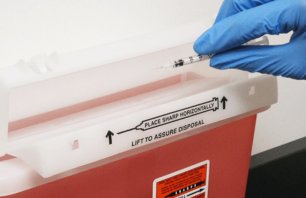Occupational exposure to bloodborne pathogens from needlesticks and other sharps injuries is a serious problem for healthcare personnel, resulting in approximately 385,000 needlesticks and other sharps-related injuries each year.
Needlestick injuries can be traumatic and life-altering events. The greatest risk of infection from bloodborne pathogens (BBPs) comes from percutaneous (through the skin) injuries by contaminated sharps such as disposable syringes, suture needles, and scalpels. The three most recognized BBPs are Human Immunodeficiency Virus (HIV), Hepatitis B (HBV), and Hepatitis C (HCV); however, in healthcare and laboratory settings, the occupational transmission of more than 20 pathogens has been reported. Healthcare organizations must comply with the Occupational Safety and Health Administration (OSHA) Bloodborne Pathogens Standard, which requires employers to protect employees from occupational exposure to blood and other potentially infectious materials.
How to Help Reduce the Risk of Exposure
OSHA and the National Institute for Occupational Safety and Health (NIOSH) outline a hierarchy of safety controls for protection from various hazards in the workplace. These controls can be used to mitigate or reduce a hazard. Healthcare facilities can help reduce the risk of exposure and potential illness or injuries by following the hierarchy, which consists of the following levels in the preferred order:
Elimination: Physically remove the hazard, which involves changing the work process to help prevent injury. This could mean halting the use of a tool.
Substitution: Replace the hazard with a safer option after considering the possible risks of the substitute and judging if it is better than the original. The newer option should not create a new risk when combined with the current work process. The Centers for Disease Control and Prevention (CDC) recommends using Prevention Through Design to help eliminate potential issues.
Engineering controls: Prevent or reduce hazards from coming into contact with workers. Engineering controls can come in the form of altering equipment, creating barriers from the hazards, and using ventilation to reduce or eliminate the chance of exposure. Engineering controls are more effective if they are already part of the original equipment design and not something that needs to be altered. Other ways engineering controls can be effective are when they remove or block the hazard from contact with workers, stop users from modifying the control, need minimal user input, and operate correctly without interfering with the work process.
Engineering controls can cost more upfront than administrative controls or personal protective equipment (PPE). However, long-term operating costs tend to be lower, especially when protecting multiple workers. Furthermore, engineering controls can save money in other areas of the work process or facility operations. There are several items to consider when using engineering controls to prevent the spread of bloodborne pathogens:
- OSHA's sharps container requirements. Containers must be closable, puncture resistant, leakproof on both sides and the bottom, labeled or color-coded, easily accessible, positioned upright, and replaced regularly.
- Sharps container placement. The NIOSH guidelines include recommended standards for sharps container installation height at healthcare facilities. Specifically, fixed sharps disposal containers should be 52” to 56” off the floor.
- Sharps container design. Lids should allow for an easy vertical drop, allowing the sharp to land safely in the container. In addition, the container should be see-through to help prevent potential overflow.
Administrative controls: Change the way people work. These changes may involve altering the frequency and duration or intensity of hazardous exposure. This requires ongoing effort to ensure maximum safety.
Personal protective equipment: PPE is worn to minimize exposure to hazards that cause serious workplace injuries and illnesses. Hospital-based healthcare programs should consider a workplace hazards assessment. This will help with PPE selection and use, inspection and replacement of damaged or worn-out PPE, employee training, and program monitoring for efficacy. Like administrative controls, this requires diligence and monitoring to help ensure worker safety. Find more information on PPE.
By following the recommended hierarchy of safety controls and training hospital-based and clinical employees, the risk of BBP infection can be significantly lower, putting an organization and its employees at less risk.
To learn more about sharps injuries and key terminology, please review our webinar on the fundamentals of sharps disposal.
Learn more about how Stericycle can help with your sharps management.



